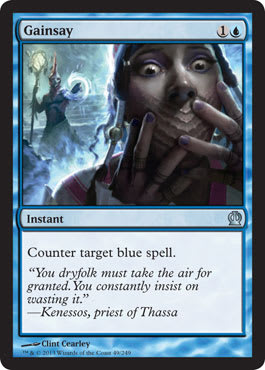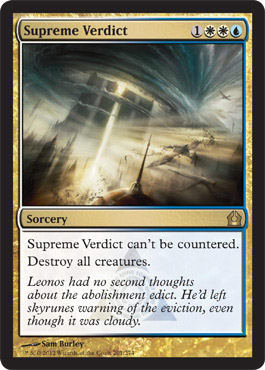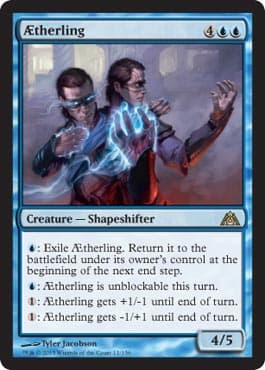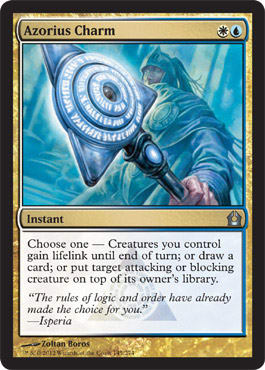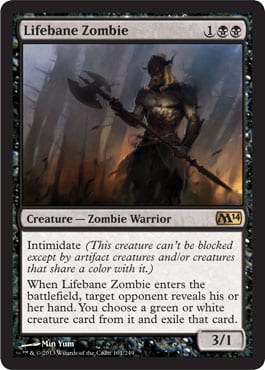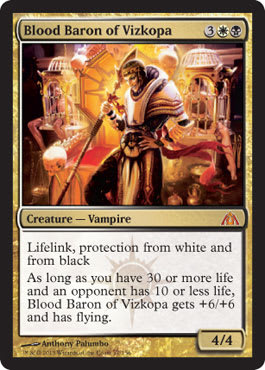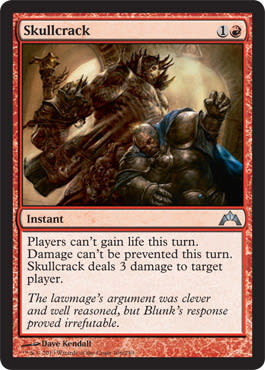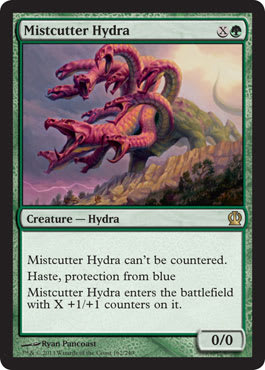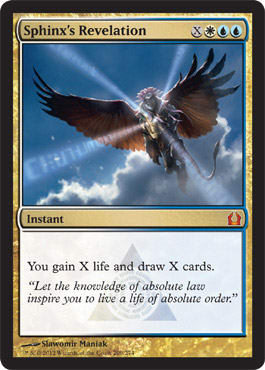Can you believe it? I am still having a tough time myself.
I only had one bye, so there was a ton of Magic to be played last weekend, and I wasn’t expecting to write a report about it since I didn’t like my chances. For those of you counting at home, I played seventeen matches and came out on top in a whopping fifteen. It would be a stretch to talk about each match individually, so I want to talk about what I learned about the matchups and what I would change in the future.
I will admit I didn’t have much time to practice the format, but I played some Pro Tour Qualifiers with various black devotion decks earlier in the season. Since I went two tournaments without a Top 8, it was time to move on, but what to play?
Esper was my go-to deck because Azorius Control decks are my favorite to play. I was going to the Grand Prix to actually relax for a weekend, so playing a boring deck was out of the question. It didn’t hurt that every article said the same thing leading up to the event: “W/U/b was awesome.”
Here’s what I played:
Esper Control — Born of the Gods Standard | Kyle Boggemes, Winner Grand Prix Cincinnati
- Creatures (1)
- 1 Aetherling
- Planeswalkers (7)
- 3 Elspeth, Sun's Champion
- 4 Jace, Architect of Thought
- Spells (25)
- 1 Last Breath
- 2 Azorius Charm
- 2 Doom Blade
- 2 Syncopate
- 4 Dissolve
- 4 Sphinx's Revelation
- 2 Thoughtseize
- 4 Supreme Verdict
- 4 Detention Sphere
- Lands (27)
- 2 Plains
- 5 Island
- 1 Godless Shrine
- 1 Watery Grave
- 2 Mutavault
- 4 Hallowed Fountain
- 4 Temple of Deceit
- 4 Temple of Enlightenment
- 4 Temple of Silence
- Sideboard (15)
- 1 Ultimate Price
- 1 Revoke Existence
- 2 Archangel of Thune
- 2 Blood Baron of Vizkopa
- 1 Thoughtseize
- 1 Duress
- 2 Negate
- 4 Nightveil Specter
- 1 Pithing Needle
The main deck is incredibly stock; in fact, I played Brad Nelson in the finals with the same fifty-eight of sixty cards without collaboration. I tried to get cute with Far // Away, but it wasn’t good enough to pull away from the list that a ton of pros have spent time tuning. It would have been a mistake to play the deck for a couple of hours and take out something potentially crucial without realizing it.
Despite my views on playing a finely-tuned sixty, the sideboard should have your own personal touch. Too often, I see players take an exact replica of a deck and not know how to sideboard. I didn’t want that to happen to me, so I took some technology from Brian Braun-Duin that made sense to me: Nightveil Specter. The card let me have a great transformational sideboard to speed up the clock for Games 2 and 3. Why would I want to play a deck for which Game 1 could take a long time but not be able to close the next two? I ended up in seventh place after the Swiss with a 13–2 record—a draw would have been effectively a loss in such a large tournament.
Remember how I said I played seventeen rounds last weekend? I boarded in Nightveil Specter fifteen times!
Just to give you an idea of my rounds, here’s what I battled:
Round 1: BYE
Round 2: W/B Devotion (win)
Round 3: Boros Burn (win)
Round 4: G/W Aggro (win)
Round 5: Boros Burn (win)
Round 6: Jund Monsters piloted by Dan Cato (win)Round 7: Mono-Black Devotion (win)
Round 8: Mono-Blue Devotion (win)
Round 9: Black Devotion with red splash piloted by David Ochoa (win)
Round 10: Mirror piloted by Alex Hayne (loss)
Round 11: Mirror (win)
Round 12: Mono-Black Devotion (loss)
Round 13: Mirror piloted by LSV (win)
Round 14: Mono-Black Devotion (win)
Round 15: Esper with more midrange spells (win)
Top 8 Quarterfinals: Blue Devotion with white splash
Top 8 Semifinals: Mono-Black Aggro
Top 8 Finals: Mirror
The only times the Nightveil Specters stayed in the sideboard was against Selesnya Aggro and Jund Monsters. I can cast all of the spells against the mirror, black devotion, and blue devotion; that’s a versatile sideboard option!
If you are going to play a nongreen deck in Standard, be prepared for Nightveil Specters out of the sideboard in Esper, as I think they are going to be very popular. The second game against Brad Nelson in the finals showcased their power even when the opponent knows they’re coming. He drew two Detention Spheres and a Supreme Verdict, and I didn’t see any Specters, so it forced him into a Rock-style strategy. If I play a Specter and it dies to a sorcery-speed spell, that’s all right with me.
LSV had his own Nightveil Specters, which happened to be the best solution to not losing to your opponent’s copy. The 2/3 flying body is very relevant in Standard, as you can easily lose to Mutavault beatdowns in the mirror after sideboard. In my second game against Luis, I drew my Last Breath for his Specter when I already had one in play; his countermagic in hand happened to be Gainsay, so I took control.
I was nervous about my burn matchup, so I cut the Gainsay from the sideboard in favor of Duress. A fourth Thoughtseize was worse in my view because I need ways to interact with Burn, but I also need enough cards for the mirror. I don’t care for Gainsay much because I am content with taking out my counters against Blue Devotion anyway in favor of the transformational strategy. Moving forward, Thoughtseize will increase in value if players adopt the Nightveil Specter strategy.
This list felt heavily advantaged against all of the popular decks except Jund Monsters. Although I defeated the monsters in Round 6, the match was very close. Two cards that didn’t impress me during the weekend were Ultimate Price and Pithing Needle in the sideboard. I only wanted the Pithing Needle to stop Domri Rade or Xenagos, the Reveler, but I should have had a more impactful card such as Fated Retribution. Their deck has so many must-answer threats after sideboard, such as Mistcutter Hydra and Sire of Insanity, so my answers need to be more robust. Pithing Needle was better in the black devotion decks because they came in against Monsters and W/U; I don’t want to board in Needles and stop my own Planeswalkers, so they lost utility.
To conclude my general thoughts about the deck, I would play the same main deck but change the sideboard:
Updated Sideboard for Esper Control
- Sideboard (15)
- 1 Devour Flesh
- 1 Revoke Existence
- 2 Archangel of Thune
- 2 Blood Baron of Vizkopa
- 1 Thoughtseize
- 1 Duress
- 2 Negate
- 4 Nightveil Specter
- 1 Fated Retribution
I want another Last Breath in the main deck, but the deck has little room for changes. The sideboard changes slightly:
I replaced Ultimate Price with Devour Flesh in the sideboard because it’s an answer to Sire of Insanity. You might think they have too many mana dorks, but most of them come out because they’re weak to Supreme Verdict. It also doubles as an answer to Obzedat, Ghost Council which is a huge problem, too. I could play Dark Betrayal, but both decks have too many threats that aren’t black. You also want more robust spells against the black decks because they have at least seven discard effects after sideboard, which makes reactive and narrow cards worse. It could be the case that I want another Devour Flesh in the sideboard because of the versatility.
Matchups
It’s important to understand how your role changes in each matchup. Everyone is ready for Esper Control after sideboard by adding additional haymakers, discard, and counters in exchange for useless removal; you can’t stop everything opponents do, so you need to speed up your clock.
I feel Esper is so powerful because most decks are prepared to fight aggressive strategies. You can’t play Standard with a deck that is warped against control when there are so many creatures. For this reason, you begin Game 1 with a huge advantage. Esper Control is also packed with creature kill spells, but that only makes the mirror match even.
The Mirror
The traditional Esper main deck will be extremely popular because two copies made the finals of a Grand Prix; people will take note. Jason Janasiewicz won StarCityGames Open Las Angeles with a similar build last weekend as well. He defeated Ricky Sidher playing a different version of—you guessed it—Esper Control. This will be a very important matchup, and the most important thing to do is play quickly. Keep in mind you need to make sure your opponent also plays at a reasonable pace. I never went to time, and I played four Esper decks in the Swiss, so a quick match can happen with Nightveil Specter.
In Game 1, both players will have some dead cards: Supreme Verdict, Doom Blade, and Last Breath. I don’t like to animate my Mutavault Game 1 often because I don’t want to waste a Dissolve to stop Doom Blade from blowing up my land. There are opportunities to use these cards effectively if you watch for openings. Doom Blade can kill an Aetherling in response to it blinking. It also kills the Soldier token your opponent targets with Detention Sphere to fizzle the ability. When both players have Aetherling, you can pull ahead in the race by forcing the opponent to blink his or hers for a turn.
Last Breath will be more important for post-board games of the mirror because it kills Nightveil Specter and Mutavault. It can also kill an opposing Archangel of Thune when Jace, Architect of Thought reduces the power, but beware of a potential Sphinx's Revelation or Last Breath gaining life in response!
The first game is typically decided by Aetherling, so protect it at all costs! You can use end-step Sphinx's Revelations to bait counters to resolve your bomb.
Sideboard:
−2 Syncopate
−2 Doom Blade
+1 Duress
+1 Thoughtseize
+2 Negate
I don’t like Detention Sphere in the mirror because opponents always board in Revoke Existence and Glare of Heresy. It also doesn’t kill Mutavault or let my Nightveil Specter attack through opponents’. I would rather have additional creatures to attack opposing Planeswalkers.
Instead of leaving in Supreme Verdicts, I just take the aggressive approach and play like a Fish deck. You don’t want to draw rancid cards such as Supreme Verdict when the opponent doesn’t cast creatures. It becomes sketchier when you have the option to discard opposing Verdicts if you happen to have a Specter in hand.
Azorius Charm is fine to leave in after sideboard because it can help in an Aetherling fight, stop an opposing Nightveil Specter, or find crucial land drops. Speaking of land drops, don’t be afraid to keep hands with too many lands even though the mirror will be filled with Thoughtseizes. Scry lands allowed me to keep some wretched hands, and I don’t think there was a game in the entire tournament in which I felt land-flooded. The deck felt more consistent than my Legacy and Modern decks.
Elspeth, Sun's Champion plays a different role after sideboard because she can come down after a Blood Baron resolves and destroy it. This is also true if you let the opponent hit you once with an Archangel of Thune. The Soldier tokens can become threats when your Archangel of Thune is in play, too. Aetherling is still the most important spell to resolve, but I don’t think there’s room in the sideboard for another copy.
Before the Grand Prix, I didn’t have a cohesive strategy for the mirror, and I was destroyed by Alex Hayne. I lost the match because Mutavault attacked me seven times. My hand had Aetherling and a couple Elspeths and counters. I could play a threat that would cause a counter war, but Alex had his own Aetherling in hand, which meant I had no good plays.
Syncopate becomes cut after sideboard so I can have room for more proactive spells. It’s a weak counter when you are trying to force through a key spell, so it is replaced by more effective disruption spells.
Black Devotion
These decks have so many creature-kill spells that make Game 1 extremely favorable for you. Beware of Thoughtseize, so don’t mulligan a land-heavy hand because it means the discard spell will be even better against six cards. Lean on your twelve scry lands, and just focus on top-decking.
They don’t have many spells that matter Game 1, but Underworld Connections is the clear MVP. Your only answers to it Game 1 are Detention Spheres and counters. If the opponent resolves it, the game is not over—he or she has twenty-five or twenty-six lands and ten dead cards to draw.
Pack Rat can get out of hand, and the opponent will only hit you with two of them and possibly a Mutavault unless it will be lethal. He or she knows you have Supreme Verdict and Detention Sphere and will play around it accordingly. Remember that the opponent can kill the Rat you target in response to Detention Sphere to save the copies.
Desecration Demon interacts differently against Elspeth now that Bile Blight exists. Before Born of the Gods, you could just continue making Soldiers to tap the Demon, but now you need to kill it with the -3 ability if possible. Bile Blight killing all of your Soldier tokens before the tap trigger means the Demon can kill Elspeth by trading a weak removal spell.
Doom Blade may seem like a completely dead card, but it still kills Mutavault. In addition, the Elspeth scenario becomes easier when you can kill the Soldier token the opponent targets with Bile Blight if using the -3 isn’t an option.
After sideboard the matchup becomes much closer for them. Mono black opponents know they are around 30% to win the first game and overcompensate to make sure they win the two post-board games.
This is how the opponent will board:
+4 Duress
Mono-Black players take out some Pack Rats, some Devour Flesh, Bile Blight, and some Hero's Downfall.
That’s a lot of hate; the deck is more aggressive, and Erebos creates a quick clock. Pack Rats become worse because you still have answers, but all of the opponent’s cards are good, so discarding is more difficult.
The opponent will still have creature-kill spells because he or she won’t be sure how many creatures you sideboard. Nightveil Specter is great against these players because it blocks opposing Specters as well as Lifebane Zombie and Mutavault. It doesn’t hurt that you can cast all of the spells in the opponent’s deck. Opponents always have to respect the possibility of Blood Baron of Vizkopa, which means leaving in Devour Flesh is good.
Here is how I sideboard against Mono-Black:
−2 Doom Blade
−3 Dissolve
−2 Thoughtseize
+1 Devour Flesh
I still like Syncopate because it stops Underworld Connections and Lifebane Zombie early. Thoughtseize seems good against the deck, but Erebos means you can’t gain your life back, and it becomes a bad draw quickly. A couple Supreme Verdicts are cut because Pack Rat is less prevalent in the second game, and I’m bringing in a bunch of creatures. I don’t want both Archangels because Erebos will keep them from growing.
After sideboard, it’s important to create scenarios in which you are both playing off the top of your decks. Remember that your opponent will have at least seven discard effects, so he or she will have weak draws in the midgame once you clear your hand; this is why most of the creatures come in.
Burn
Game 1 is tough because Skullcrack can stop the life-gain from Sphinx's Revelation. An early Chandra's Phoenix or Ash Zealot can deal plenty of damage if you don’t have an early way to answer creatures, too. Mutavault also makes me feel that my opponent is drawing cards every time it hits me for 2. Thoughtseize can be awkward, but it can hit a Skullcrack, which is a big plus in the first game.
After sideboard, I felt like a huge favorite against Burn. Even when I lost the first game to it in one of the matches, I was still confident because my sideboard plan is so effective.
−2 Thoughtseize
−1 Aetherling
+1 Duress
+2 Negate
+1 Devour Flesh
Burn opponents will board in Firedrinker Satyr, which makes their aggressive plans stronger; luckily for you, Nightveil Specter will jump in front of it. Other potential creatures you may face are Spark Trooper and Viashino Firstblade, which demand instant-speed answers. Supreme Verdict is weak because you want to aggressively cast your lifelink creatures, and it’s bad against haste.
I board in Nightveil Specter and never attack with it unless I am already too far ahead to lose. It is a creature that blocks Ash Zealot, Mutavault, Firedrinker Satyr, and Chandra's Phoenix and lives to tell the tale. I boarded it in during my first Burn matchup and was extremely impressed.
I used the +1 ability on Jace against burn to great effect. It shrinks haste monsters, and the opponent needs to eventually deal damage to it because the ultimate is very good against. You are able to steal a Warleader's Helix from the opponent’s deck and cast an Archangel of Thune from your deck.
The main reason I have a critical mass of lifelinking creatures in my sideboard is to have a good plan against burn. Elspeth and Aetherling are terrible win conditions because they don’t help stabilize in this matchup, and the switch is very effective.
Jund Monsters
Game 1 is pretty good as long as you don’t let a Domri Rade or Xenagos stay in play. Monsters players have blank cards, such as Mizzium Mortars, and Dreadbore is also mediocre. When you blow up an Elspeth, I am happy because you are playing a reactive game against the most controlling deck in the format. Elspeth’s +1 ability is fine against monsters, but it’s really just another answer to Stormbreath Dragon.
The reason Doom Blade is in the main deck is to also handle Stormbreath Dragon. You need to ration your spells that answer the pro-white creature because it can win from nowhere. I like Thoughtseize in this matchup because the opponent will try to draw out a Supreme Verdict by playing one threat and waiting for a sweeper. Thoughtseize will stop the next threat when you tap low to answer what’s on the board.
Sideboard:
−1 Last Breath
+1 Devour Flesh
+1 Thoughtseize
This is a creature deck that doesn’t want to see Doom Blade and Thoughtseize, so there aren’t many dead cards Game 1. Jund Monsters players will completely transform their decks after sideboard.
Cards you need to worry about post-board are: Mistcutter Hydra, Sire of Insanity (people are moving away from Ruric Thar, the Unbowed because it is immune to Doom Blade), Rakdos's Return, and Golgari Charm.
That’s a lot of strong spells!
Golgari Charm will blow up your Detention Spheres, but you still need them to handle Domri Rade and Xenagos. You may think it’s sneaky to board out your Spheres to blank opposing Charms, but they still counter your Supreme Verdict and most of a Fated Retribution.
You need an answer to Sire of Insanity, and Fated Retribution is a reasonable choice. The additional sweeper answers Mistcutter Hydra and Stormbreath Dragon as well. It’s not a staple spell, so your opponent may only play around Sphinx's Revelation and be hit by this bad boy instead.
The creature sideboard plan doesn’t work because there are so many giant monsters that need to be immediately swept. Archangel of Thune doesn’t match up well against Stormbreath Dragon, and Blood Baron doesn’t play well against Polukranos, World Eater.
Monsters opponents will be slower out of the gates because Sylvan Caryatid will come out for haymakers. It’s extremely awkward to have your mana destroyed as well as the big monster. This is why Devour Flesh replaced the Ultimate Price. If you are worried about this matchup, you can add a Blind Obedience and an additional Devour Flesh in your sideboard.
Conclusion
I did infinitely better than I expected at Grand Prix Cincinnati, and I would suggest that Esper is still the best deck in the format. The week leading up the Grand Prix featured many articles on the deck in various forms, but it still had a great showing in multiple events. The scry lands push a deck like Esper Control over the top because the format is slow enough to justify playing lands that enters the battlefield tapped.
The matchups described sum up my Grand Prix experience. Expect to face plenty of Black Devotion, Esper Control, Burn, and Jund Monsters. There are some other decks out there, but make sure to practice those matchups.
Esper may look like an intimidating deck to play, but there aren’t too many decisions, and you are still rewarded with consistency. I think it’s the most fun deck to play in the format, and that’s why I think I won.
Thanks for reading, and I hope I can bring you a winning tournament report for Pro Tour Portland!
-Kyle
















